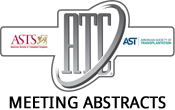2015 American Transplant Congress
Non-Chimeric HLA-Identical Renal Transplant Tolerance: Regulatory Immunophenotypic/Genomic Biomarkers
Background. We previously described 3-year results of a non-chimeric tolerance protocol in HLA-identical living donor renal transplant (RT) recipients and now report on longer term,…2015 American Transplant Congress
Cardiosphere-Derived Cells from Cadaver Can Improve Heart Function in a Model of Non-Ischaemic Dilated Cardiomyopathy
Objectives: Cardiosphere-derived cells (CDCs) are mainly obtained through myocardial biopsy, and could improve cardiac function and attenuate remodeling in myocardial infarction. In this study, we…2015 American Transplant Congress
Mesenchymal Stem Cells (MSCs) Transfusion for Desensitization of Positive Lymphocyte Cross Match (LCM) or Panel Reactive Antibodies (PRA) Before Kidney Transplantation – Outcome of 16 Cases
Immunomodulatory function of MSCs may correct positive PRA or LCM in highly-sensitized patients. We evaluate donor specific or 3rd party MSCs transfusion in 16 patients…2015 American Transplant Congress
Stable and Unstable Chimerism During Immunosuppressive Drug Withdrawal in Tolerant Recipients of HLA Matched Combined Kidney and Hematopoietic Cell Transplants
1Surgery, Stanford University, Palo Alto, CA; 2Medicine, Stanford University, Palo Alto, CA.
Our previous studies showed that 75-80% of HLA matched recipients of combined kidney and hematopoietic cell transplants conditioned with total lymphoid irradiation (TLI) and anti-thymocyte…2015 American Transplant Congress
Mesenchymal Stem Cells Prevent Cold Ischemia-Reperfusion Injury in Lung Transplants
Background: Cold ischemia-reperfusion injury (IRI) is a major cause of graft failure in lung transplantation. Despite therapeutic benefits of mesenchymal stem cells (MSCs) in attenuating…2015 American Transplant Congress
Vaccine Responses in Combined Hematopoeitic Stem Cell-Kidney Transplant Recipients
Background: Vaccines remain one of the most effective methods of preventing infections following transplantation. Data suggests that vaccine responses are reduced in recipients of hematopoeitic…2015 American Transplant Congress
Six Year Follow-Up of a Phase 2 Clinical Trial to Induce Tolerance in Mismatched Living Donor Renal Transplant Recipients
27 subjects have been transplanted in a phase 2 protocol (IDE 13947) based upon tolerogenic CD8+/TCR- facilitating cells (FCRx) and 200 cGy TBI-based nonmyeloablative conditioning…2015 American Transplant Congress
Orthotopic Transplantation of a Tissue Engineered Skin Graft in Athymic Mice
Surgery, Gothenburg University, Gothenburg, Vastra Gotaland, Sweden.
Background: Tissue engineered (TE) skin offers promising alternative treatment in wound healing of acute and chronic skin injuries. Limited autografts from donor skin and risks…2015 American Transplant Congress
A Novel Humanized Mouse Model for the Study of Induced Pluripotent Stem Cell-Derived Tissue Transplantation Tolerance and Function
Surgery/Transplant Division, University of Wisconsin-Madison, Madison, WI.
Patient-specific induced pluripotent stem cells (iPSCs) hold great promise for regenerative medicine therapies, theoretically allowing for the creation of autologous replacement tissues devoid of many…2015 American Transplant Congress
Pancreas-Derived Mesenchymal Stem Cells from Chronic Pancreatitis Patients Enhance Islet Graft Function
PURPOSE: Islet transplantation represents a promising procedure to reverse or prevent diabetes. However, significant mass of islet graft is lost within hours of transplantation due…
